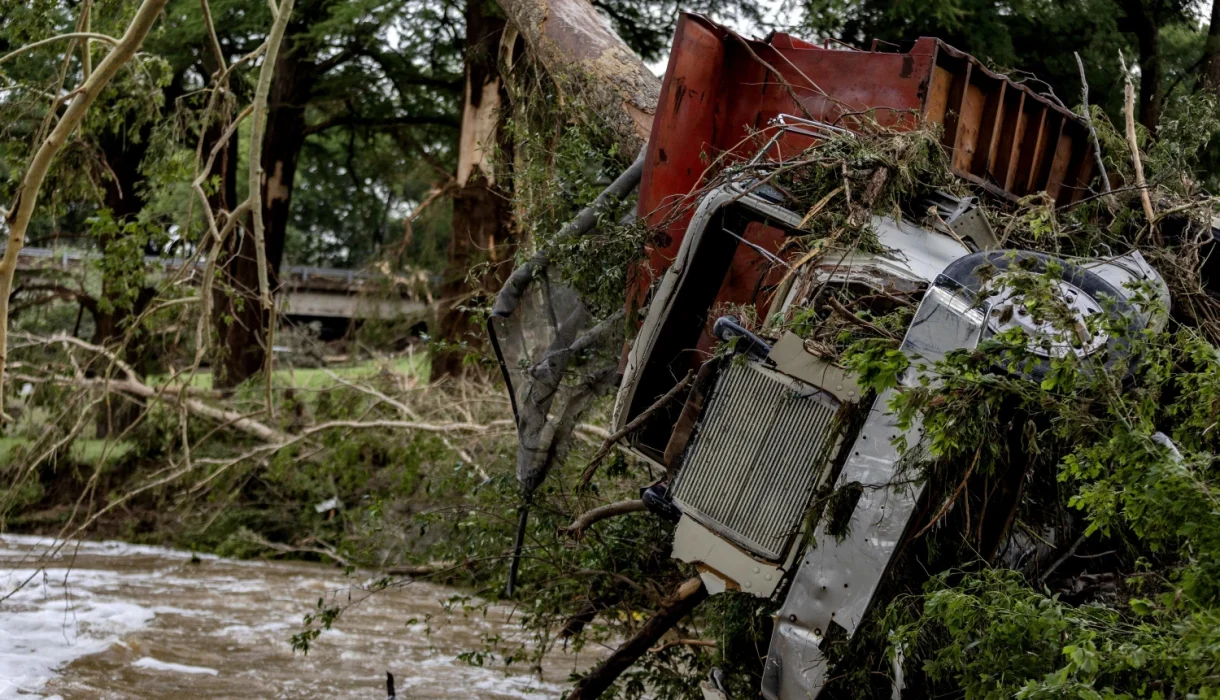
Trump Pretends Not to Hear Difficult Question on Texas Deaths.
Posted in :
When asked about deadly Texas floods and federal staffing cuts to FEMA and the National Weather Service, Trump claimed he “couldn’t hear” the question. The evasion highlights a troubling pattern of deflecting responsibility during crises.
A critical look at how President Trump handled tough questions regarding federal cutbacks and their alleged role in the devastating Texas floods, exploring political deflection, emergency preparedness, and public accountability.
When natural disasters strike, official press conferences can become as stormy as the weather outside. Several years ago, while covering a routine city council meeting, I watched a local politician pull the classic ‘I didn’t catch that’ to dodge a tricky budget question—then watched the reporter sheepishly repeat it, only to get another non-answer. This memory came rushing back as I watched President Trump seemingly ‘not hear’ a reporter asking about federal cuts and the tragic Texas flood deaths. With dozens lost and many missing after catastrophic flash floods in Texas, the stakes are life and death. How leaders respond—in word and deed—matters for every community.
The Press Conference Shuffle: Questions (Un)Heard
When President Donald Trump faced the press in New Jersey following the catastrophic Texas floods, the event quickly became a case study in the delicate dance between government accountability and political self-preservation. The Trump press conference, intended to address the federal response to the Texas flood deaths, instead drew attention for what was left unsaid—and, more specifically, unanswered.
The devastation in Texas was staggering: more than 80 people lost their lives, and over 40 remained missing after flash floods swept through central Texas. As the nation looked for answers, critics pointed to the Trump administration’s previous staffing cuts at the National Weather Service (NWS) and the Federal Emergency Management Agency (FEMA), raising questions about whether these reductions had hindered storm prediction and disaster response. It was a moment ripe for tough questions and, potentially, tough answers.
During the press conference, a reporter projected a question that cut straight to the heart of the controversy: “Democrats are blaming your federal cuts for the deaths over in Texas.” The question was clear, direct, and—according to multiple reporters at the scene—loud enough to be heard by everyone present. Yet, President Trump’s response was to lean in, pause, and then wave off the inquiry with a now-memorable phrase:
“I can’t hear you.” – President Donald Trump
The moment was striking, not only for its timing but for its familiarity. Political figures often find themselves under the spotlight during national emergencies, and the instinct to sidestep uncomfortable scrutiny is hardly new. Still, the optics of the Trump Texas flood response press conference were hard to ignore. The president, who had been engaging with other questions just moments before, suddenly could not hear when pressed about federal staffing cuts and their possible connection to the Texas flood deaths.
Observers noted that this was not simply a case of poor acoustics. Reporters at the scene confirmed the question was “loud and clear.” The exchange quickly became symbolic of a broader pattern: when faced with difficult or potentially damaging questions, leaders sometimes choose to deflect rather than engage. In this case, the shuffle was literal—Trump moved on to another reporter, leaving the original question hanging in the air.
The press conference continued, but the tone had shifted. When asked later if he would investigate whether cuts at the NWS and FEMA had left critical positions vacant, Trump and Commerce Secretary Howard Lutnick both shook their heads. Trump insisted, “They didn’t,” before shifting blame, suggesting, “You look at that water situation, that was really the Biden setup. That was not our setup. But I wouldn’t blame Biden for it either; I would just say this is a hundred-year catastrophe, and it’s just so horrible to watch.”
Pressed further about whether the federal government should consider rehiring meteorologists lost to the administration’s “slash-and-burn” downsizing, Trump’s answer was vague: “I wouldn’t know that. I really wouldn’t. I would think not. This was a thing that happened in seconds. Nobody expected it, nobody saw it. Very talented people are there and they didn’t see it.”
However, the National Weather Service offered a different perspective. According to an NWS spokesperson, the agency had issued forecast briefings and warnings hours before the floods struck. “Flash Flood Warnings were also issued on the night of July 3 and in the early morning of July 4, giving preliminary lead times of more than three hours before flash flooding conditions occurred,” the spokesperson told the Daily Beast. This statement directly contradicted the implication that the disaster was entirely unforeseen.
The Trump press conference, held far from the disaster zone in New Jersey, underscored the tension between transparency and political calculation. While the president expressed sympathy for the victims—“We’re working very close with representatives from Texas. And it’s a horrible thing that took place, absolutely horrible”—the avoidance of direct accountability for federal staffing decisions left many questions unresolved.
Research shows that critics continue to link the scale of the Texas flood deaths to Trump-era cuts at the National Weather Service and FEMA. The pattern of evading direct press scrutiny, especially in crisis situations, is not unique to this administration, but the stakes in moments like these are undeniably high. As reporters moved on, the tough questions about the Trump Texas flood response remained, echoing long after the cameras stopped rolling.
The Blame Game: Disaster, Cuts, and Political Dodgeball
In the aftermath of the devastating Texas floods, which left at least 80 people dead and dozens missing, the national conversation quickly turned to the federal government’s role in disaster preparedness. At the center of this debate: the impact of National Weather Service cuts and FEMA staffing cuts made during the Trump administration, and whether these reductions played a part in the tragic outcome.
Critics Draw a Direct Line: Staffing Cuts and Flood Deaths
Almost immediately, critics highlighted the connection between Trump-era federal workforce reductions and the severity of the Texas floods. Many pointed to the National Weather Service cuts—which included reduced staffing and a restructuring of emergency roles—as a potential factor that may have limited the agency’s ability to respond effectively. The same scrutiny fell on FEMA staffing cuts, with some arguing that a leaner federal response team could not keep up with the scale of the disaster.
One reporter, during a press conference in New Jersey, asked President Trump directly about these concerns: “Democrats are blaming your federal cuts for the deaths over in Texas.” The question was clear, and the reporter’s voice carried across the room. Yet, Trump’s response was to wave off the inquiry, stating, “I can’t hear you,” before moving on to another topic.
Dodging Accountability: Trump’s Response
When pressed further about whether the administration’s cuts at the National Weather Service and FEMA left key positions vacant, Trump and Commerce Secretary Howard Lutnick simply shook their heads. “They didn’t,” Trump insisted. He then shifted the focus, suggesting, “You look at that water situation, that was really the Biden setup. That was not our setup. But I wouldn’t blame Biden for it either; I would just say this is a hundred-year catastrophe, and it’s just so horrible to watch.”
This pattern—redirecting blame and avoiding direct engagement with the topic of federal cuts—left many critics unsatisfied. Trump’s reluctance to address whether the government should rehire meteorologists who lost their jobs during the administration’s downsizing was also telling. “I wouldn’t know that. I really wouldn’t. I would think not,” he said. “This was a thing that happened in seconds. Nobody expected it, nobody saw it. Very talented people are there and they didn’t see it.”
National Weather Service Warnings: Advance Notice Amid Staffing Strains
Despite the controversy over National Weather Service cuts, the agency maintains that it provided timely and effective warnings. According to a spokesperson, “Flash Flood Warnings were also issued on the night of July 3 and in the early morning of July 4, giving preliminary lead times of more than three hours before flash flooding conditions occurred.” This statement underscores that, even with a reduced workforce, the National Weather Service warnings were delivered well in advance of the disaster.
Research shows that these warnings were communicated, yet some Texas officials and emergency managers still felt caught off-guard. They argued that rainfall estimates were underestimated and that the severity of the flooding was not fully predicted by federal advisories. This disconnect between federal forecasts and local perceptions fueled further debate about the effectiveness of the Texas floods response.
Political Dodgeball and Public Frustration
The public discourse quickly became a game of political dodgeball. On one side, critics and local officials questioned whether National Weather Service cuts and FEMA staffing cuts compromised the ability to prepare for and respond to the floods. On the other, Trump distanced himself from the issue, framing the disaster as an unpredictable, once-in-a-century event and redirecting attention to the current administration.
Meanwhile, the National Weather Service stood by its record, emphasizing that warnings were issued in line with established protocols. The agency’s spokesperson reiterated, “Flash Flood Warnings were also issued… giving preliminary lead times of more than three hours.” Still, the question lingered: did diminished staffing contribute to the disaster’s severity, or was this truly an unavoidable catastrophe?
As the blame game played out in the media and political arenas, families in Texas continued to search for missing loved ones, and emergency crews worked around the clock. The debate over federal preparedness and the adequacy of the Texas floods response remains unresolved, with both sides pointing to the same facts but drawing very different conclusions.
What Happens After the Waters Recede?
As Texas begins to confront the long road ahead in the wake of catastrophic flooding, the Texas flood aftermath has quickly become a flashpoint for national debate. The devastation—at least 80 lives lost and over 40 still missing—has not only left communities shattered, but also exposed deep questions about disaster preparedness, federal-state collaboration, and the impact of government staffing decisions on public safety.
In the days following the disaster, President Donald Trump addressed reporters from New Jersey. When pressed about whether federal cuts, particularly to the National Weather Service and FEMA, contributed to the scale of the tragedy, Trump sidestepped the question. Although he leaned in as if to listen, he ultimately waved off the inquiry, stating, “I can’t hear you,” before moving on. This moment, captured on video and widely shared, has fueled criticism about the administration’s willingness to confront tough questions regarding the Texas flood response.
Later, when asked directly if he would consider rehiring meteorologists or restoring positions lost during his administration’s downsizing, Trump appeared uncertain. “I wouldn’t know that. I really wouldn’t. I would think not,” he responded. He went on to describe the flooding as a “hundred-year catastrophe,” emphasizing that “nobody expected it, nobody saw it.” Yet, the National Weather Service has publicly stated that it issued flash flood warnings hours before the disaster struck, with lead times of more than three hours. This discrepancy has only intensified scrutiny of both the accuracy of forecasts and the capacity of agencies to act on them.
The Texas Division of Emergency Management has acknowledged that underestimated rainfall forecasts complicated the response, highlighting a critical gap between prediction and action. Research shows that readiness in the face of natural disasters depends not just on early warnings, but also on the infrastructure and staffing necessary to mobilize effective responses. In this context, the debate over meteorologist staffing in 2025 and beyond takes on new urgency. The ongoing search and rescue operations underscore the need for robust, reliable disaster response services—services that are only as strong as the people and resources behind them.
As the state moves from immediate rescue efforts to long-term recovery, questions about Texas flood recovery plans remain at the forefront. Federal and state collaboration is being tested once again, with many pointing to the importance of clear communication and coordination across agencies. Trump’s announcement that he would visit Texas “probably on Friday” has sparked further discussion about the timing and visibility of national leadership in the aftermath of disaster. Some argue that such visits can distract from local recovery efforts, while others see them as a necessary show of support and accountability.
Meanwhile, the search for survivors continues, and the rebuilding process is only beginning. The scale of the destruction has made it clear that future preparedness cannot be an afterthought. Previous experiences with disaster response—both successes and failures—offer important lessons: readiness is not just about having warnings in place, but about ensuring the infrastructure, funding, and staffing to act on those warnings swiftly and effectively.
As debates rage over whether federal cutbacks compromised Texas’s readiness, one thing is certain: the need for strong, well-coordinated disaster response services has never been more apparent. The aftermath of the Texas floods has exposed vulnerabilities in the nation’s approach to emergency management, from meteorologist staffing to interagency coordination. As policymakers and the public grapple with these issues, the hope is that the tragedy will serve as a catalyst for meaningful change.
“We’re working very close with representatives from Texas.” – President Donald Trump
Ultimately, what happens after the waters recede will depend on the willingness of leaders at every level to confront uncomfortable questions, invest in preparedness, and prioritize the safety of communities. The Texas flood aftermath is a sobering reminder that the true measure of disaster response lies not only in the warnings issued, but in the actions taken—and the lives saved—when nature’s fury strikes.
TL;DR: President Trump’s evasiveness at a press conference about Texas flood deaths underscores ongoing questions about government responsibility, emergency preparedness, and accountability in the face of disaster.
TexasFloodsResponse, TrumpFederalDisasterDeclaration, NationalWeatherServiceCuts, TexasFloodDeaths, FEMAStaffingCuts, FlashFloodWarningsTexas, TrumpPressConference, MeteorologistStaffing2025, TexasFloodAftermath, BidenAdministrationCriticism,TrumpFEMAcutsTexasfloodresponse, NationalWeatherServicelayoffs, disasterpreparednessfailure, Trumpdodgespress, Texasflooddeaths2025
#TexasFloods, #DisasterResponse, #TrumpPressConference, #FederalCuts, #WeatherService, #FEMA, #FlashFloods, #TexasNews, #PoliticalAccountability,##Trump #TexasFloods #FEMA #DisasterResponse #PressFreedom #Accountability #ClimateCrisis #GovernmentCuts #NationalWeatherService #2025Politics

